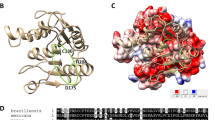Abstract
We have previously shown that various species of Leishmania produce a lytic activity, which, in Leishmania amazonensis, is mediated by a pore-forming cytolysin, called leishporin. It is toxic for macrophages in vitro and optimally active at pH 5.0 to 5.5 and at 37 °C, suggesting that it might be active inside phagolysosomes. Leishporin from both L. amazonensis (a-leishporin) and Leishmania guyanensis (g-leishporin) can be activated by proteases, suggesting either a limited proteolysis of an inactive precursor or a proteolytic degradation of a non-covalently linked inhibitor. Here, we show that both a- and g-leishporin are also activated in dissociating conditions, indicating the second hypothesis as the correct one. In fact, we further demonstrated that inactive leishporin is non-covalently associated with an inhibitor, possibly more than one oligopeptide that, when removed, renders leishporin hemolytically active. This activation was shown to be the result of both the improvement of leishporin’s ability to bind to phospholipids and the emergence of its pore-forming ability. In vitro results demonstrate that leishporin can be released by the parasites, as they evolve in axenic cultures, in an inactive form that can be activated. These results are compatible with our hypothesis that leishporin can be activated in the protease-rich, low pH, and dissociating environment of parasitophorous vacuoles, leading to disruption of both vacuoles and plasma membranes with the release of amastigotes.





Similar content being viewed by others
Abbreviations
- CHAPSO:
-
3[(3-Cholamidopropyl) dimethyl-ammonio]-2-hydroxy-propanesulfonate
- DPPC:
-
Dipalmitoylphosphatidyl choline
- (g-HCl):
-
Guanidine-HCl
- HEPES:
-
N-2-Hydroxyethylpiperazine-N’-2-ethanesulfonic acid
- H50 :
-
Inverse of the dilution that caused 50 % of hemolysis
- HuE:
-
Human erythrocytes
- mExt:
-
Promastigotes membrane detergent-soluble extract
- PFP:
-
Pore-forming protein(s)
- PBS:
-
Phosphate-buffered saline
References
Abrami L, Fivaz M, Decroly E, Seidah NG, Jean F, Thomas G, Leppla SH, Buckley JT, van der Goot FG (1998) The pore-forming toxin proaerolysin is activated by furin. J Biol Chem 273:32656–32661
Almeida-Campos FR, Horta MF (2000) Proteolytic activation of leishporin: evidence that Leishmania amazonensis and Leishmania guyanensis have distinct inactive forms. Mol Biochem Parasitol 111:363–375
Almeida-Campos FR, Noronha FSM, Horta MF (2002) The multitalented pore-forming proteins of intracellular pathogens. Microb Infection 4:741–750
Andrews NW, Portnoy DA (1994) Cytolysins of intracellular pathogens. Trends Microbiol 2:261–263
Bangham AD, Standish MM, Watkins JC (1965) Diffusion of univalent ions across the lamellae of swollen phospholipids. J Mol Biol 13:238–252
Castro-Gomes T, Almeida-Campos FR, Calzavara-Silva CE, da Silva RA, Frézard F, Horta MF (2009) Membrane binding requirements for the cytolytic activity of Leishmania amazonensis leishporin. FEBS Lett 583:3209–3214
Handman E (1999) Cell Biology of Leishmania. Adv Parasitol 44:1–39
Horta MF (1997) Pore-forming proteins in pathogenic protozoan parasites. Trends Microbiol 5:363–366
Hybiske K, Stephens RS (2008) Exit strategies of intracellular pathogens. Nature Rev Microbiol 6:99–109
Leippe M, Bruhn H, Hecht O, Grötzinger J (2005) Ancient weapons: the three dimensional structure of amoebapore A. Trends Parasitol 21:5–7
Noronha FSM, Cruz JS, Beirão PSL, Horta MF (2000) Macrophage damage by Leishmania amazonensis cytolysin: evidence of pore formation. Infect Immun 68:4578–4584
Noronha FSM, Ramalho-Pinto FJ, Horta MF (1994) Identification of a putative pore-forming hemolysin active at acid pH in Leishmania amazonensis. Braz J Med Biol Res 27:477–482
Noronha FSM, Ramalho-Pinto FJ, Horta MF (1996) Cytolytic activity in the genus Leishmania: involvement of a putative pore-forming protein. Infect Immun 64:3975–3982
Roiko MS, Carruthers VB (2009) New roles for perforins and proteases in apicomplexan egress. Cell Microbiol 11:1444–1452
Wilson ME, Jerônimo SMB, Pearson RD (2005) Immunopathogenesis of infection with the visceralizing Leishmania species. Microb Pathogenesis 38:147–160
Acknowledgments
We thank Elimar Faria’s technical assistance. Financial support: UNICEF/UNDP/World Bank/WHO Special Program for Research and Training in Tropical Diseases, Fundação de Amparo à Pesquisa do Estado de Minas Gerais, and Programa de Apoio a Núcleos de Excelência. FRAC and TCG were supported by Coordenadoria de Aperfeiçoamento de Pessoal do Ensino Superior. MFH and FF are Conselho Nacional de Desenvolvimento Científico e Tecnológico research fellows.
Author information
Authors and Affiliations
Corresponding author
Additional information
Flávia Regina Almeida-Campos and Thiago Castro-Gomes contributed equally to the experimental work performed for this manuscript.
Rights and permissions
About this article
Cite this article
Almeida-Campos, F.R., Castro-Gomes, T., Machado-Silva, A. et al. Activation of Leishmania spp. leishporin: evidence that dissociation of an inhibitor not only improves its lipid-binding efficiency but also endows it with the ability to form pores. Parasitol Res 112, 3305–3314 (2013). https://doi.org/10.1007/s00436-013-3510-4
Received:
Accepted:
Published:
Issue Date:
DOI: https://doi.org/10.1007/s00436-013-3510-4




